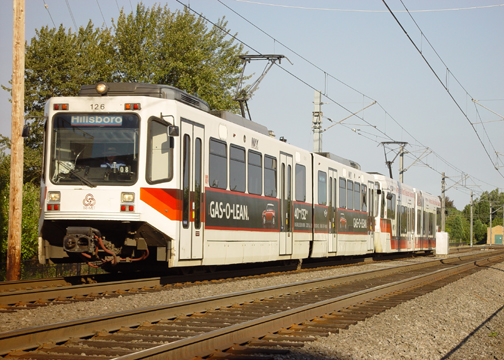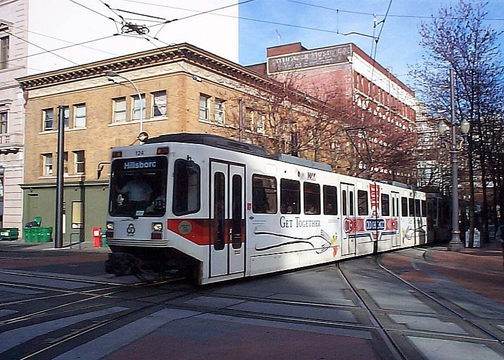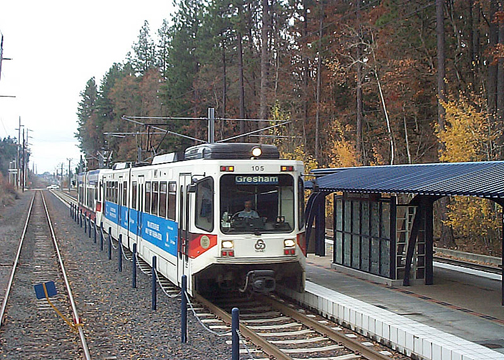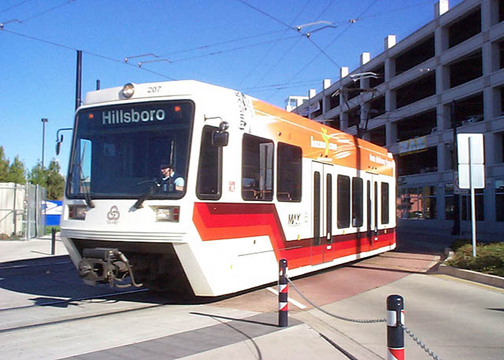 |
 |
| MAX -- The Metropolitan Area Express -- is the light rail system operated by TriMet in the Portland metropolitan area. It began operations Sep. 5, 1986 on a 15-mile line from downtown Portland east to downtown Gresham. |  |
|
The original MAX route followed a diverse combination of rights-of-way, including on-street running through downtown Portland and the Lloyd District, separated trackage alongside Interstate 84, the center median of East Burnside Street (itself an old streetcar right-of-way), and parts of an old Portland Traction Company interurban line. MAX came about following the "Freeway Revolt" that emerged as popular opposition to the proposed Mount Hood Expressway, connecting Portland and Gresham through southeast Portland. The route would have cut a wide swathe through several eastside neighborhoods. Instead, the funds proposed for the highway project were applied to the east side light rail corridor. Construction began in 1981; it took about five years to build the line. |
 |
The agency's light rail fleet first consisted of 26 100-series cars built by Bombardier, a Canadian manufacturing company, under license from Belgian railcar manufacturer CFM. They were wheelchair-accessible by using a hydraulic lift located on each station platform. Car #124, one of the original 100-series cars, is shown here entering at the original 11th Avenue turnback loop in downtoan Portland. |
|
These original cars were delivered to the MAX shop complex in Gresham using another old interurban route, the East Portland Traction line between southeast Portland and Gresham, following portions of the old Cazadero line and the Troutdale branch. For most of its first 12 years, MAX operated on a weekday schedule of 15-minute headways during off-peak hours and 10-minute headways during rush hour. Reduced schedules were offered on weekends and holidays. Most trains operated with two cars, with some early and late off-peak services using single cars (the two-car length of MAX trains was, and remains, dictated by the length of street blocks in downtown Portland, which do not allow longer train lengths without blocking intersections.) |
| TriMet extended
light rail from downtown Portland west to Hillsboro in September 1998 on
the 18-mile Westside MAX.
The five years of construction
included drilling twin 3-mile-long tunnels under Portland's Washington Park and the deepest transit station in North America 260 feet below the Oregon Zoo. Car #105 is shown here leading a 200-series Siemens car on an eastbound run at the Beaverton Creek station. |
 |
|
The agency also re-used sections of the old Oregon Electric interurban railway line between downtown Beaverton and downtown Hillsboro. Rail transit service returned to the two cities for the first time since 1933. The first portion of the line, from downtown to SW Salmon in the Goose Hollow neighborhood, opened on Aug. 31, 1997. Delays in the construction of the Washington Park tunnels, caused primarily by slow going through some of the underground rock layers, kept TriMet from opening the line as far as 185th Avenue in Beaverton, as originally planned. |
 |
The opening of the route's initial leg in 1997 was also the first use of low-floor light rail cars in North America -- the first 12 of a planned 46 SD600 cars constructed by the German company Siemens. The main floor level on each car is level with the platform height at each station. |
|
The body shells for this fleet were built in Germany, but final assembly took place at a Siemens plant in Sacramento, Calif. The cars were delivered to TriMet on railroad flatcars and dropped off at an unloading ramp connecting the Westside line with a Portland & Western railroad spur between the Beaverton Creek and Merlo Road stations. The inauguration of west side service and the new low-floor cars also coincided with service increases and improvements along the entire route. A "bridge plate" that extended from the car side when the doors open allowed the cars to handle wheelchairs, strollers and bicycles. It eliminated the need for the hydraulic wheelchair lifts, and speeded up station stops considerably. The added equipment also provided enough rolling stock to run two-car trains at all times. It significantly increased capacity during the September 1997 closure of one span of the I-5 Interstate Bridge for lift mechanism repairs -- a closure that greatly increased ridership on the east side, particularly from the Gateway Transit Center. |
| Click here to continue the MAX story... |
|